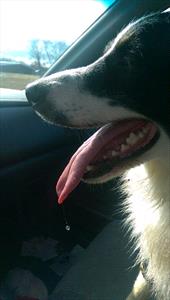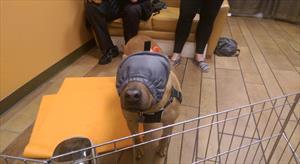Dog riding in car

Photo courtesy of Christine Calder
Many people love to take their dog on errands and fun adventures in the car. Some even take their cats. Some dogs and cats become anxious in the car with others refusing to enter the car at all. What can we do?
Anxiety in the car is a common behavior among both dogs and cats. There are many different reasons for this including movement of the car, car noises, or sights and sounds outside the window.
Step 1: Rule Out Motion Sickness
Many of the behaviors your dog displays when nauseous mimic anxiety, such as licking lips, drooling, and panting. If left untreated, motion sickness leads to anxiety about the car.
Cerenia®, an FDA approved medication, is effective at preventing motion sickness in dogs. If the anxious behavior does not persist, then motion sickness was likely the cause.
Step 2: Pheromones and Aromatherapy
Adaptil®, a pheromone, is an odorless message specific to dogs that can help dogs feel calm and relaxed during times of stress. Feliway®, is the cat version. Pheromones are sprayed on the floorboards, in your pet’s carrier, and where your pet rides.
Wait 10 minutes before letting your pet back in their carrier or car and never spray directly on your pet.
Lavender, chamomile, and sandalwood scents are thought to reduce anxiety and have a positive effect on behavior and mood. A study was published showing dogs spent significantly more time resting and sitting and less time moving and vocalizing during car rides when lavender was introduced for car rides.
Step 3: Window Shades and Thundercaps
Blocking the view outside can be dangerous to the driver. Tools such as small window shades or a Thundercap are helpful in reducing both motion sickness and car ride anxiety.
Dog with thundercap

Photo courtesy of Christine Calder
Step 4: Seatbelts and Crates
If you use a carrier, teach your pet to enjoy the carrier. Covering the carrier or crate helps your pet feel safe and secure when traveling.
Harnesses that attach to a seatbelt improve safety. Several seatbelt harness combinations have been crash test certified by the Center for Pet Safety.
Step 5: Long-Term Treatment
There are many approaches to decreasing your pet’s anxiety in the car. All techniques start with a calm and relaxed animal. Conditioning relaxation on a mat or the use of a Treat&Train® are helpful when modifying this behavior.
Step 6: Medication
Medications can be helpful when reducing anxiety in the car. Talk with your veterinarian about options for your pet.